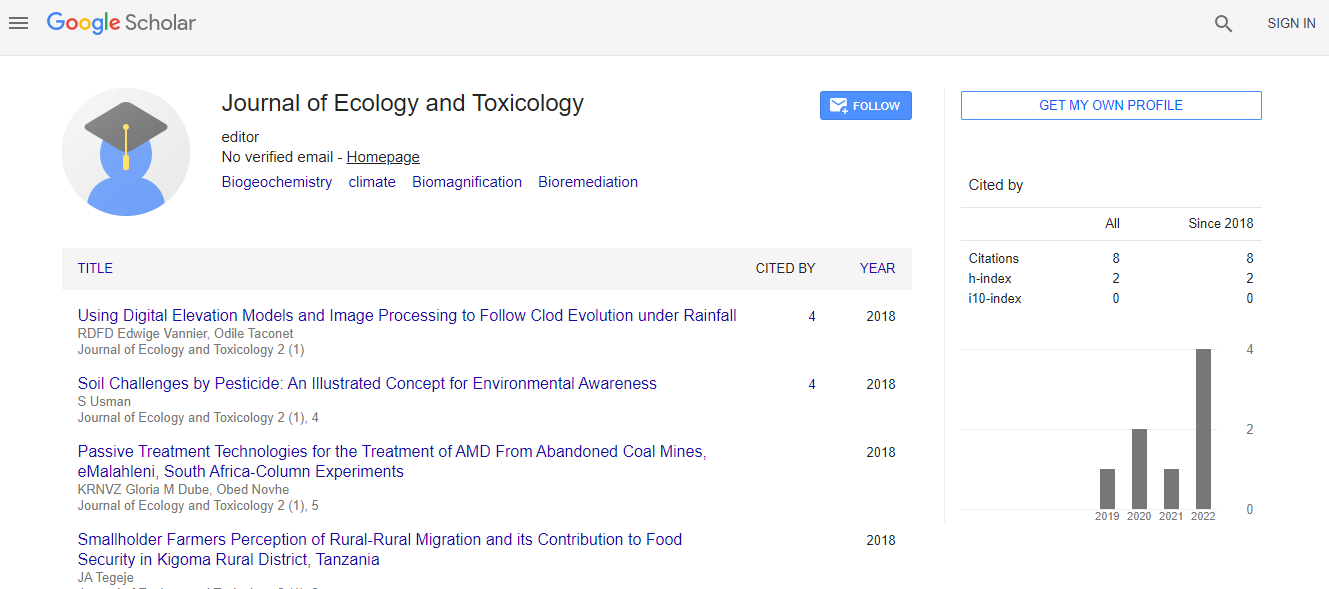Our Group organises 3000+ Global Conferenceseries Events every year across USA, Europe & Asia with support from 1000 more scientific Societies and Publishes 700+ Open Access Journals which contains over 50000 eminent personalities, reputed scientists as editorial board members.
Open Access Journals gaining more Readers and Citations
700 Journals and 15,000,000 Readers Each Journal is getting 25,000+ Readers
Google Scholar citation report
Citations : 8
Journal of Ecology and Toxicology received 8 citations as per Google Scholar report
Indexed In
- Google Scholar
Useful Links
Recommended Journals
Related Subjects
Share This Page
Editorial Board
Submit Manuscript
Journal Impact Factor 0.08*
Submit manuscript at or send as an e-mail attachment to the Editorial Office at manuscript@omicsonline.org
If you are interested in publishing with us or have any questions, please feel free to contact us directly on WhatsApp .
Table of Contents
About the Journal
Soil Contamination
Soil Contamination, soil pollution, or land pollution as a part of land degradation is caused by the presence of xenobiotic (human-made) chemicals or other alteration in the natural soil environment. It is typically caused by industrial activity, agricultural chemicals or improper disposal of waste. The most common chemicals involved are petroleum hydrocarbons, polynuclear aromatic hydrocarbons solvents, pesticides, lead, and other heavy metals. Contamination is correlated with the degree of industrialization and intensity of chemical substance.
Cyanobacteria
Cyanobacteria formerly known as blue-green algae, is photosynthetic microscopic organisms that are technically bacteria. They were originally called blue-green algae because dense growths often turn the water green, blue-green or brownish-green. There have been reports from around the globe of cyanobacteria producing toxins in fresh waters. These algae are found in all lakes and are a natural part of the lake ecosystem. Unfortunately, high nutrient concentrations can promote a population explosion of these organisms and result in algal blooms, especially during warm weather.
Environmental monitoring
Environmental monitoring is a tool to assess environmental conditions and trends, support policy development and its implementation, and develop information for reporting to national policymakers, international forums and the public. Over the past decade, only a few countries of Europe and Central Asia have been able to maintain existing monitoring activities. The monitoring of urban air pollution an important human health risk is poor in many cities of the subregion.
Water Quality
Water quality refers to the condition and characteristics of water that determine its suitability for various uses and the health of aquatic ecosystems. It encompasses the chemical, physical, and biological properties of water and the presence of contaminants and pollutants. Monitoring and maintaining good water quality is crucial for human health, ecosystem sustainability, and the overall well-being of communities. In natural water bodies such as lakes, rivers, and oceans, various factors can influence water quality. These include natural processes like weathering, erosion, and biological interactions, as well as human activities such as industrial discharges, agricultural runoff, and improper waste disposal.
Microcystins
Microcystins (MCs) are a family of potent hepatotoxins. MCs are cyclic heptapeptide cyanotoxins that are produced by several genera of cynaobacteria. More than 100 different MC congeners have been recognized. Microcystins are cyclic heptapeptides. The seven amino acids that are involved in the structure of a microcystin include the unique amino acids ADDA and D-β-methyl-isoaspartatel
Ecological Niche
An ecological niche is the role and position a species has in its environment; how it meets its needs for food and shelter, how it survives, and how it reproduces. A species' niche includes all of its interactions with the biotic and abiotic factors of its environment.
Molecular Ecology
Molecular ecology is the study of interactions and a state of different things of natural population. Molecular ecological research became more attainable with the development of rapid and accessible genetic technologies, such as the polymerase chain reaction. Molecular ecology revealed promiscuous sexual behaviour and multiple male partners in tree swallows previously thought to be socially monogamous. In a biogeographically context, the marriage between genetics, ecology, and evolution resulted in a new sub-discipline called phytogeography.
Biogeochemistry and Climate
Biogeochemistry is the study and measure nutrient budgets to understand how these materials are regulated, flow, and recycled through the environment. This research has led to an understanding that there is global feedback between ecosystems and the physical parameters of this planet, including minerals, soil, pH, ions, water, and atmospheric gases. Six major elements like hydrogen, carbon, nitrogen, oxygen, sulphur, and phosphorus form the constitution of all biological macromolecules and feed into the Earth's geochemical processes.
Wind and Turbulence
Wind and turbulent forces affect the environment and ecosystem distribution through air and wind. On a planetary scale, ecosystems are affected by circulation patterns in the global trade winds. Wind power and the turbulent forces it creates can influence heat, nutrient, and biochemical profiles of ecosystems. Example, wind running over the surface of a lake creates turbulence, mixing the water column and influencing the environmental profile to create thermally layered zones, affecting how fish, algae, and other parts of the aquatic ecosystem are structured.
Human Ecology
Human ecology is an interdisciplinary investigation into the ecology of our species. Human ecology may be defined as the study of man as the ecological dominant in plant and animal communities and systems, a bio-ecological point of view as simply another animal affecting and being affected by his physical environment and as a human being, somehow different from animal life in general, interacting with physical and modified environments in a distinctive and creative way.
Climate Change
Human-made carbon dioxide continues to increase above levels not seen in hundreds of thousands of years. Currently, about half of the carbon dioxide released from the burning of fossil fuels remains in the atmosphere. The rest is absorbed by vegetation and the oceans. Future climate change and associated impacts will differ from region to region around the globe. Anticipated effects include global warming, rising sea levels, changing precipitation, and expansion of deserts in the subtropics.
Global warming
Increase of Earth's average surface temperature due to effect of greenhouse gases, such as carbon dioxide emissions from burning fossil fuels or from deforestation, which trap heat that would otherwise escape from Earth.
Radioactive wastes
Waste containing radioactive material is called radioactive waste. Radioactive waste is usually a by-product of nuclear power generation and other applications of nuclear fission or nuclear technology, such as research and medicine. Radioactive waste is hazardous to most forms of life and the environment, and is regulated by government agencies in order to protect human health and the environment.
Persistent organic pollutants
POPs are a set of toxic chemicals that are persistent in the environment and able to last for several years before breaking down. POPs circulate globally and chemicals released in one part of the world can be deposited at far distances from their original source through a repeated process of evaporation and deposition. This makes it very hard to trace the original source of the chemical. POPs are lipophilic, which means that they accumulate in the fatty tissue of living animals and human beings. In fatty tissue, the concentrations can become magnified by up to 70 000 times higher than the background levels.
Bioremediation
Treatment that uses naturally occurring organisms to break down hazardous substances into less toxic or non-toxic substances is called bioremedation. Technologies can be generally classified as in situ or ex situ. In situ bioremediation involves treating the contaminated material at the site, while ex situ involves the removal of the contaminated material to be treated elsewhere.
Eutrophication
Eutrophication is characterized by excessive plant and algal growth due to the increased availability of one or more limiting growth factors needed for photosynthesis such as sunlight, carbon dioxide, and nutrient fertilizers. Human activities have accelerated the rate and extent of eutrophication through both point-source discharges and non-point loadings of limiting nutrients, such as nitrogen and phosphorus, into aquatic ecosystems (i.e., cultural eutrophication), with dramatic consequences for drinking water sources, fisheries, and recreational water bodies.
Biomagnification
Biomagnification, also known as bioamplification or biological magnification, is the increasing concentration of a substance, such as a toxic chemical, in the tissues of organisms at successively higher levels in a food chain.
Ecological Succession
Observed process of change in the species structure of an ecological community over time is known as Ecological succession. The time scale can be decades or even millions of years after a mass extinction. In ecological succession an ecological community undergoes more or less orderly and predictable changes following a disturbance or the initial colonization of a new habitat.
Ecological Pyramids
Ecological pyramid is also known as trophic pyramid or energy pyramid, it is graphically represented to show the biomass or productivity of the biomass at each trophic level in an ecosystem. They are graphical representations of the structure of trophic levels of ecosystems.
Microenvironment
Microenvironmnet is a very small, specific area in a habitat, distinguished from its immediate surroundings by factors such as the amount of incident light, the degree of moisture, and the range of temperatures.
Food Pyramid
A food pyramid is described as successive levels of predation in a food chain represented schemattically as a pyramid-shaped diagram representing the optimal number of servings to be eaten each day from each of the basic food groups.
Ecology and Toxicology is a branch of science which deals with the relationships between organism and their natural environment and effects of harmful substances on organism at population community and ecosystem level. Journal of Ecology and Toxicology, a peer reviewed, Open Access Journal provides an open platform for eminent scientists around the globe to publish their scholarly work in field related to organism association with their ecological niche and effects incurred by various deleterious toxic substances to organism and their effects at each level of ecological hierarchy. Various regulatory approaches for toxic chemicals management are included in scope of Journal of Ecology and Toxicology.
Submit manuscript at https://www.scholarscentral.org/submission/ecology-toxicology.html or send as an e-mail attachment to the Editorial Office at manuscripts@omicsonline.com
Journal Highlights
Fast Editorial Execution and Review Process (FEE-Review Process):
Journal of Ecology and Toxicology is participating in the Fast Editorial Execution and Review Process (FEE-Review Process) with an additional prepayment of $99 apart from the regular article processing fee. Fast Editorial Execution and Review Process is a special service for the article that enables it to get a faster response in the pre-review stage from the handling editor as well as a review from the reviewer. An author can get a faster response of pre-review maximum in 3 days since submission, and a review process by the reviewer maximum in 5 days, followed by revision/publication in 2 days. If the article gets notified for revision by the handling editor, then it will take another 5 days for external review by the previous reviewer or alternative reviewer.Acceptance of manuscripts is driven entirely by handling editorial team considerations and independent peer-review, ensuring the highest standards are maintained no matter the route to regular peer-reviewed publication or a fast editorial review process. The handling editor and the article contributor are responsible for adhering to scientific standards. The article FEE-Review process of $99 will not be refunded even if the article is rejected or withdrawn for publication.
The corresponding author or institution/organization is responsible for making the manuscript FEE-Review Process payment. The additional FEE-Review Process payment covers the fast review processing and quick editorial decisions, and regular article publication covers the preparation in various formats for online publication, securing full-text inclusion in a number of permanent archives like HTML, XML, and PDF, and feeding to different indexing agencies.
h-index
Articles published in Journal of Ecology and Toxicology have been cited by esteemed scholars and scientists all around the world. Journal of Ecology and Toxicology has got h-index 2, which means every article in Journal of Ecology and Toxicology has got 2 average citations.
Recently Published Articles
-
As-tolerant P-A strain of Pantoea ananatis: a potential PGPR, isolated from the Hezhou mining area in China
-
The conceptual debate on climate change and sustainability versus economic growth and development of states. A deep reflection on our common future
-
Enhancing air pollution mitigation by urban green infrastructure
-
Climate change of pollution and its destructive effect on mechanical, physical and tonal qualities of historical albumin photographs prints
-
Conference Announcement on Pollution Control 2021
-
Impact on climate change on historical photograph damage

 Spanish
Spanish  Chinese
Chinese  Russian
Russian  German
German  French
French  Japanese
Japanese  Portuguese
Portuguese  Hindi
Hindi 




